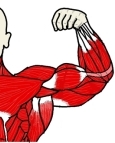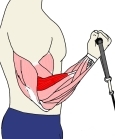腕橈骨筋 ( わんとうこつきん、 英:brachioradialis muscle )
・ 概 要 |
・ 作 用 |
・ イラスト掲載サイト |
|
・ イラスト |
・ 神経 / 脈管 |
||
・ 起始 / 停止 |
・ Wikipedia |
![]()


![]()
・ 肘関節より少し指寄りの部分で膨らみを作る(容易に触診が可)。 ⇒ イラスト解説
筋連結 : 上腕三頭筋
「Rauber-Kopsch解剖学」には以下のような解説が見られる。
「 変異 : この筋の欠如は橈骨が欠けている例にみられる.この筋の全体が重複していることはまれであるが,相ならんであるいは重なって付着している2つの腱が見られることは比較的に多い.その起始は三角筋の停止にまで達していることがある.この筋が第3中手骨,舟状骨,大多角骨に停止することが見られている.また前腕筋膜,三角筋,上腕筋,長母指外転筋,長橈側手根伸筋との結合が知られている. 」
![]()
|
|||||
![]()
【 起 始 】 : 上腕骨の外側縁下部1/3、 外側上腕筋間中隔
![]()
「 前腕を屈曲するとともに、これをわずかに外転する。」 ( 日本人体解剖学 )
![]()
・ 神 経 : 橈骨神経 (C5,C6)
The brachioradialis is a muscle of the forearm that flexes the forearm at the elbow.[1][2] It is also capable of both pronation and supination, depending on the position of the forearm. It is attached to the distal styloid process of the radius by way of the brachioradialis tendon, and to the lateral supracondylar ridge of the humerus.
【 Structure 】
The brachioradialis is a superficial, fusiform muscle on the lateral side of the forearm. It originates proximally on the lateral supracondylar ridge of the humerus. It inserts distally on the radius, at the base of its styloid process. Near the elbow, it forms the lateral limit of the cubital fossa, or elbow pit.
【 Nerve supply 】
Despite the bulk of the muscle body being visible from the anterior aspect of the forearm, the brachioradialis is a posterior compartment muscle and consequently is innervated by the radial nerve. Of the muscles that receive innervation from the radial nerve, it is one of only four that receive input directly from the radial nerve. The other three are the triceps, anconeus, and extensor carpi radialis longus. (All other posterior compartment muscles that receive radial innervation are supplied by the deep branch of the radial nerve.)
【 Function 】
The brachioradialis flexes the forearm at the elbow. When the forearm is pronated, the brachioradialis tends to supinate as it flexes.[2] In a supinated position, it tends to pronate as it flexes. This also assists the biceps brachii.
The brachioradialis is a stronger elbow flexor when the forearm is in a midposition between supination and pronation at the radioulnar joint. When pronated, the brachioradialis is more active during elbow flexion since the biceps brachii is in a mechanical disadvantage.
With the insertion of the muscle so far from the fulcrum of the elbow, the brachioradialis does not generate as much joint torque as the brachialis or the biceps. It is effective mainly when those muscles have already partially flexed at the elbow. The brachioradialis flexes the forearm at the elbow, especially when quick movement is required and when a weight is lifted during slow flexion of the forearm.
The muscle is used to stabilize the elbow during rapid flexion and extension while in a midposition, such as in hammering. The brachioradialis is synergistic with the brachialis and biceps brachii; the triceps brachii and anconeus are antagonistic.
【 語 句 】
・ pronation : 回内運動 ・ supination : 回外運動 ・ styloid process : 茎状突起 ・ radius : 橈骨 ・ lateral supracondylar ridge : 外側上顆稜 ・ humerus : 上腕骨 ・ usiform : 紡錘状の ・ cubital fossa : 肘窩 ・ consequently : 従って ・ anconeus : 肘筋 ・ extensor carpi radialis longus : 長橈側手根伸筋 ・ biceps brachii : 上腕二頭筋 ・ radioulnar joint : 橈尺関節 ・ fulcrum : 支点 ・ brachialis : 上腕筋 ・ synergistic : 協力作用の ・ antagonistic : 相反する
![]()










